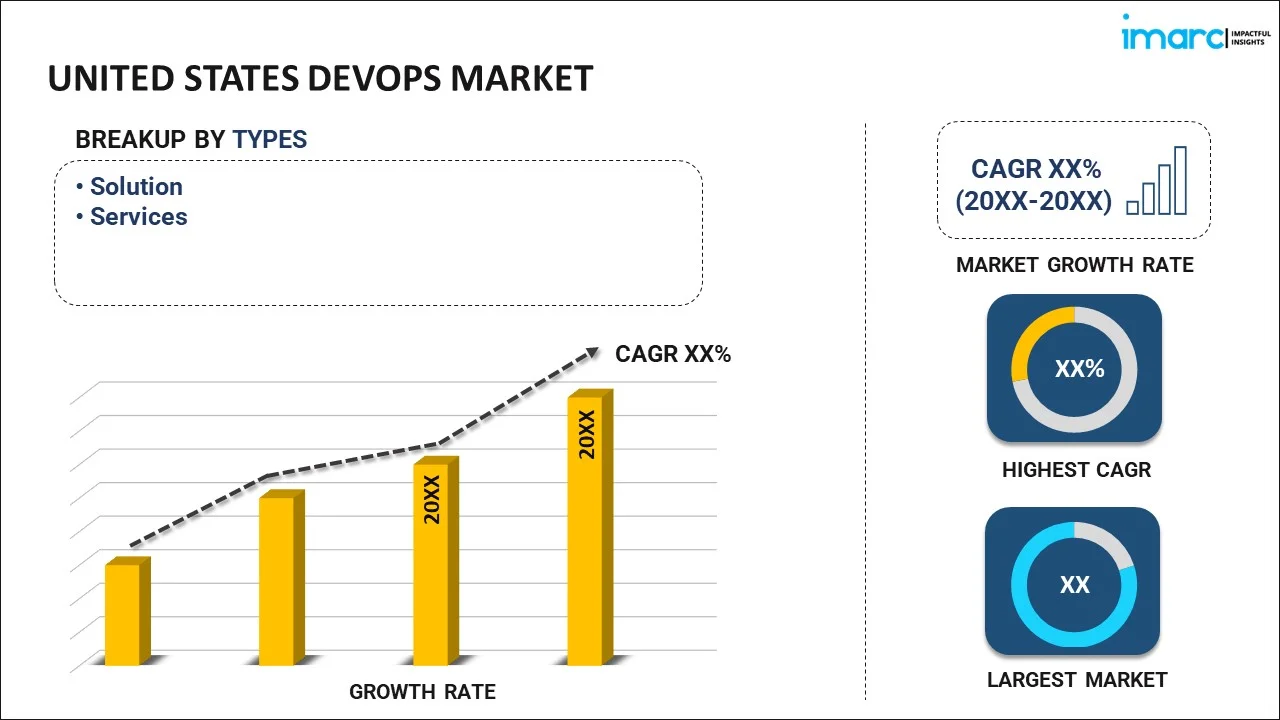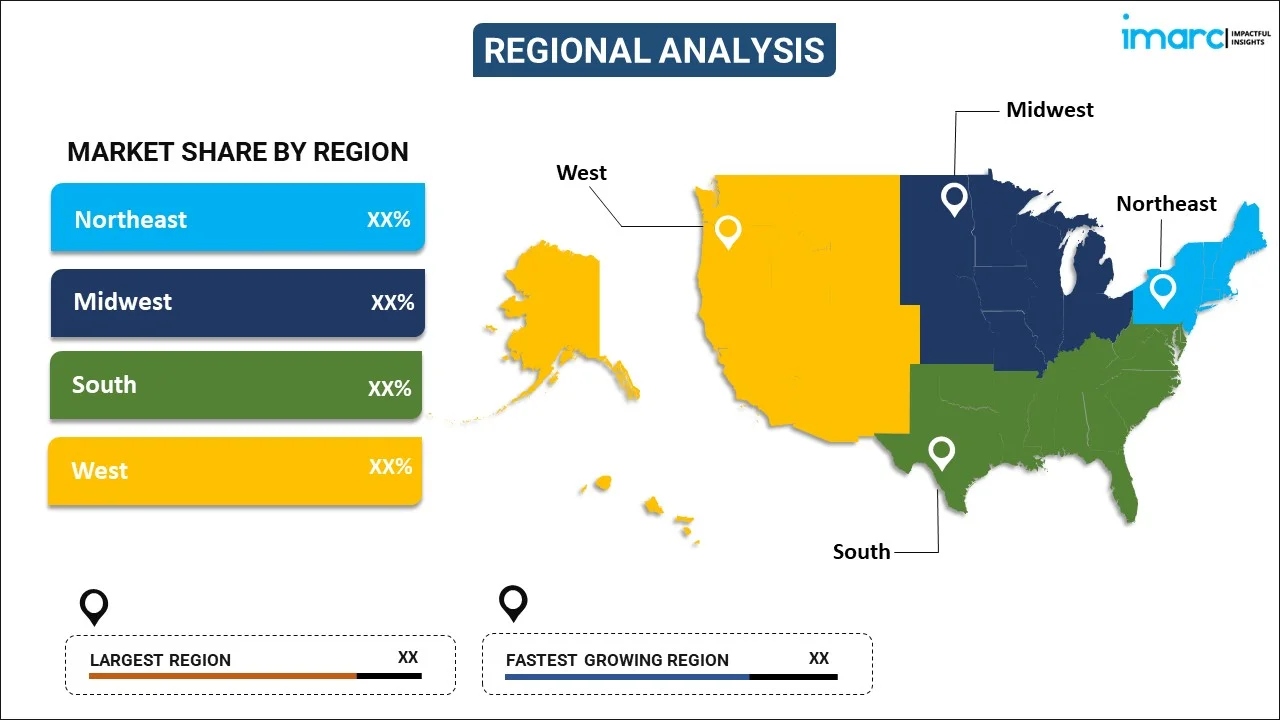
United States DevOps Market Report by Type (Solution, Services), Deployment Model (Public Cloud, Private Cloud, Hybrid Cloud), Organization Size (Large Enterprises, Medium-Sized Enterprises, Small-Sized Enterprises), Tool (Development Tools, Testing Tools, Operation Tools), Industry Vertical (Telecommunications and Information Technology Enabled Services (ITES), Banking, Financial Services, and Insurance (BFSI), Retail, Manufacturing, Healthcare, Government and Public Sector, and Others), and Region 2025-2033
Market Overview:
United States DevOps market size reached USD 2.7 Billion in 2024. Looking forward, IMARC Group expects the market to reach USD 16.9 Billion by 2033, exhibiting a growth rate (CAGR) of 22.6% during 2025-2033. The introduction of high-quality software solutions, along with the widespread adoption of hybrid systems, is primarily driving the market growth across the country.
|
Report Attribute
|
Key Statistics
|
|---|---|
|
Base Year
|
2024
|
|
Forecast Years
|
2025-2033
|
|
Historical Years
|
2019-2024
|
|
Market Size in 2024
|
USD 2.7 Billion |
|
Market Forecast in 2033
|
USD 16.9 Billion |
| Market Growth Rate 2025-2033 | 22.6% |
DevOps encompasses a collection of practices, principles, and cultural philosophies with the objective of improving collaboration and communication between software development (Dev) and IT operations (Ops) teams. Its core aim is to optimize and automate the process of software delivery and deployment, enabling organizations to achieve faster and more reliable development, testing, and release of software. DevOps emerges as a solution to address the shortcomings of traditional approaches to software development and deployment, where the segregation of development and operations teams resulted in inefficiencies, delays, and an increased likelihood of errors. By fostering a collaborative and communicative environment, DevOps seeks to streamline workflows, enhance efficiency, and reduce the complexities associated with software development and deployment practices.
United States DevOps Market Trends:
The United States DevOps market stands as a pivotal force in the realm of software development and IT operations, embodying a comprehensive set of practices, principles, and cultural philosophies. Additionally, this market is characterized by a dynamic framework aimed at fostering collaboration and communication between software development (Dev) and IT operations (Ops) teams. Besides this, the primary objective of the United States DevOps market is to revolutionize and automate the software delivery and deployment process, facilitating organizations in achieving heightened efficiency, speed, and reliability in their development cycles. Moreover, recognizing the limitations of traditional software development approaches that often led to siloed operations, inefficiencies, and delays, the DevOps market in the United States offers a transformative solution. Furthermore, organizations within various sectors, including technology, finance, healthcare, and beyond, are increasingly adopting DevOps practices to overcome challenges and ensure seamless collaboration between development and operations teams, which is acting as another significant growth-inducing factor. Apart from this, the growing emphasis on the automation of business processes in diverse industries, coupled with a rising desire for serverless computing, is expected to fuel the United States DevOps market over the forecasted period.Top of FormTop of Form
United States DevOps Market Segmentation:
IMARC Group provides an analysis of the key trends in each segment of the market, along with forecasts at the country level for 2025-2033. Our report has categorized the market based on type, deployment model, organization size, tools, and industry vertical.
Type Insights:

- Solution
- Services
The report has provided a detailed breakup and analysis of the market based on the type. This includes solution and services.
Deployment Model Insights:
- Public Cloud
- Private Cloud
- Hybrid Cloud
A detailed breakup and analysis of the market based on the deployment model have also been provided in the report. This includes public cloud, private cloud, and hybrid cloud.
Organization Size Insights:
- Large Enterprises
- Medium-Sized Enterprises
- Small-Sized Enterprises
The report has provided a detailed breakup and analysis of the market based on the organization size. This includes large enterprises, medium-sized enterprises, and small-sized enterprises.
Tools Insights:
- Development Tools
- Testing Tools
- Operation Tools
A detailed breakup and analysis of the market based on the tools have also been provided in the report. This includes development tools, testing tools, and operation tools.
Industry Vertical Insights:
- Telecommunications and Information Technology Enabled Services (ITES)
- Banking, Financial Services, and Insurance (BFSI)
- Retail
- Manufacturing
- Healthcare
- Government and Public Sector
- Others
The report has provided a detailed breakup and analysis of the market based on industry vertical. This includes telecommunications and information technology enabled services (ITES), banking, financial services, and insurance (BFSI), retail, manufacturing, healthcare, government and public sector, and others.
Regional Insights:

- Northeast
- Midwest
- South
- West
The report has also provided a comprehensive analysis of all the major regional markets, which include Northeast, Midwest, South, and West.
Competitive Landscape:
The market research report has also provided a comprehensive analysis of the competitive landscape. Competitive analysis such as market structure, key player positioning, top winning strategies, competitive dashboard, and company evaluation quadrant has been covered in the report. Also, detailed profiles of all major companies have been provided.
United States DevOps Market Report Coverage:
| Report Features | Details |
|---|---|
| Base Year of the Analysis | 2024 |
| Historical Period | 2019-2024 |
| Forecast Period | 2025-2033 |
| Units | Billion USD |
| Scope of the Report | Exploration of Historical Trends and Market Outlook, Industry Catalysts and Challenges, Segment-Wise Historical and Future Market Assessment:
|
| Types Covered | Solution, Services |
| Deployment Models Covered | Public Cloud, Private Cloud, Hybrid Cloud |
| Organization Sizes Covered | Large Enterprises, Medium-Sized Enterprises, Small-Sized Enterprises |
| Tools Covered | Development Tools, Testing Tools, Operation Tools |
| Industry Verticals Covered | Telecommunications and Information Technology Enabled Services (ITES), Banking, Financial Services, and Insurance (BFSI), Retail, Manufacturing, Healthcare, Government and Public Sector, Others |
| Regions Covered | Northeast, Midwest, South, West |
| Customization Scope | 10% Free Customization |
| Post-Sale Analyst Support | 10-12 Weeks |
| Delivery Format | PDF and Excel through Email (We can also provide the editable version of the report in PPT/Word format on special request) |
Key Questions Answered in This Report:
- How has the United States DevOps market performed so far and how will it perform in the coming years?
- What has been the impact of COVID-19 on the United States DevOps market?
- What is the breakup of the United States DevOps market on the basis of type?
- What is the breakup of the United States DevOps market on the basis of deployment model?
- What is the breakup of the United States DevOps market on the basis of organization size?
- What is the breakup of the United States DevOps market on the basis of tools?
- What is the breakup of the United States DevOps market on the basis of industry vertical?
- What are the various stages in the value chain of the United States DevOps market?
- What are the key driving factors and challenges in the United States DevOps?
- What is the structure of the United States DevOps market and who are the key players?
- What is the degree of competition in the United States DevOps market?
Key Benefits for Stakeholders:
- IMARC’s industry report offers a comprehensive quantitative analysis of various market segments, historical and current market trends, market forecasts, and dynamics of the United States DevOps market from 2019-2033.
- The research report provides the latest information on the market drivers, challenges, and opportunities in the United States DevOps market.
- Porter's five forces analysis assist stakeholders in assessing the impact of new entrants, competitive rivalry, supplier power, buyer power, and the threat of substitution. It helps stakeholders to analyze the level of competition within the United States DevOps industry and its attractiveness.
- Competitive landscape allows stakeholders to understand their competitive environment and provides an insight into the current positions of key players in the market.
Need more help?
- Speak to our experienced analysts for insights on the current market scenarios.
- Include additional segments and countries to customize the report as per your requirement.
- Gain an unparalleled competitive advantage in your domain by understanding how to utilize the report and positively impacting your operations and revenue.
- For further assistance, please connect with our analysts.
 Request Customization
Request Customization
 Speak to an Analyst
Speak to an Analyst
 Request Brochure
Request Brochure
 Inquire Before Buying
Inquire Before Buying




.webp)




.webp)












